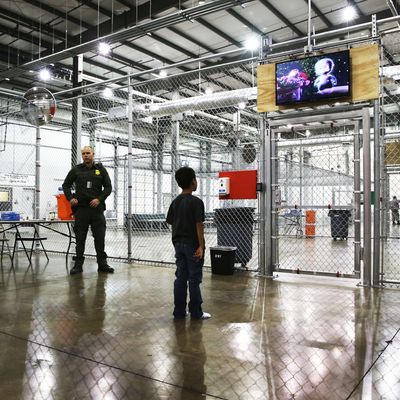
In late May, before the uproar over the Trump administration’s family separations policy had reached fever pitch, several prominent journalists and activists tweeted disturbing photos published in the Arizona Republic from a facility that allegedly housed minors who had been wrenched from their parents. The pictures showed children, covered only in a thin layer of aluminum foil, sleeping in cages.
“I saw this photo floating around and didn’t know if it was real. It is,” activist Shaun King wrote, in a representative post. “Children of immigrants are being held in cages, like dogs, at ICE detention centers, sleeping on the floor. It’s an abomination.”
But there was one problem. The photos, it turned out, were from 2014, during the Obama administration’s second term.
Right-wing outlets (and the president) gleefully pounced on the mistake, most of the people who had disseminated the photos dutifully corrected the record, and everyone moved on. But partisan point-scoring aside, the tweets did raise an uncomfortable question that has been lurking in the background of the families-separation crisis: Had Democrats paid enough attention to the harsh immigration policies put into place by President Obama?
The generally accepted narrative of Obama’s evolution on immigration policy is as follows: During his first term, the 44th president put his focus squarely on rescuing the economy and passing health-care reform, leaving the heavy lifting on immigration for a later date. Before 2013, back when real immigration reform seemed possible (though never probable), he adopted a severe approach to deportations in an ill-fated effort to convince skeptical Republicans that he would uphold his part of a grand bargain — a deal that never arrived. During his second term, unencumbered by expectations of a deal, he went in the other direction, announcing his wide-ranging, Deferred Action for Childhood Arrivals policy and easing up on the enforcement.
As a thorough Migration Policy journal article from last year laid out, the reality is a bit more complicated.
Obama did set a record for deportations during his presidency, using the metric of “formal removals.” A confluence of factors during Obama’s tenure, which included a pronounced drop in border-crossers compared with the first years of the 2000s, meant that the actual number of people apprehended and sent back across the border was far higher during the George W. Bush years. But the number of people fingerprinted, processed, and officially deported to their home countries soared under Obama, with 2013 setting a high-water mark of 435,498. The administration justified the policy as an effort — at least partially successful — to discourage recidivism.
Throughout his presidency, Obama did put a priority on removing migrants who had committed violence in the past, or who had only recently crossed the border. In late 2014, he codified this approach with an executive order that specifically directed ICE not to deport those who posed little threat to the country. Still, a controversial “bed mandate” quota incentivized ICE to jail immigrants with no record of violent offenses, though many of them were allowed to stay in the country.
Beyond the deportation numbers, there were other questionable choices that are less well remembered. Responding to a 2014 crisis involving thousands of unaccompanied Central American minors attempting to cross the border, the Obama administration responded by detaining thousands of immigrant families and paying the Mexican government to intercept families before they reached the U.S, actions that drew sharp – if not widespread — criticism for treating the crisis more as a border-security issue than a humanitarian one. Two years later, some families who made the journey during that time and settled in the U.S. were deported.
The Obama administration also embraced, and defended, the use of privately run family detention centers, the unpleasantness of which seemed to serve as a deterrent for future Central American immigrants.
And then there were those cages. When the Arizona Republic published the now-infamous 2014 photos, the accompanying article described the Nogales, Texas, facility that held unaccompanied minors as clean and air-conditioned, but ultimately a “juvenile prison camp.” Many of the buildings that now house children separated from their parents were put to heavy use in the mid-2010s.
There is also no question that Obama presided over an immigration apparatus that ballooned in size and power under his watch. Immigration and Customs Enforcement, the post 9/11-born agency that many liberal activists now want to abolish, saw its budget skyrocket budget during the Obama years, as did U.S. Customs and Border Protection — all the way to a combined $20 billion in 2016.
If President Trump really does implement mass deportations, it will be with the help of an enforcement machine Obama helped construct, or at least maintained.
Much of this was well documented by mainstream news outlets at the time. But it is also undeniable that the level of scrutiny directed at Obama by the Democratic base — outside of immigration activists — was relatively minimal throughout his tenure.
It is difficult to know if this is because Democrats simply had faith in their president to take a humane and thoughtful approach to the issue, or precisely the role that sheer partisanship played. But it is also undeniable that the party has moved sharply left on immigration in a dizzyingly short period of time. As Axios pointed out in February, Bill Clinton’s 1996 reelection campaign invoked, in Trump-like language, “criminal immigrants, deported after committing crimes in America,” who “returned the very next day to commit crimes again”; Paul Krugman made an economic case against immigration in 2006, an unimaginable position for him to take today; even Obama himself wrote in his book Audacity of Hope, from the same year, that, “When I see Mexican flags waved at pro-immigration demonstrations, I sometimes feel a flush of patriotic resentment.”
Immigration skepticism, in other words, was quite recently part and parcel of being a Democrat. That changed during the Obama years — a Pew poll found that after 2010, the percentage of Democrats who believe that immigrants “strengthen the country because of their hard work and talents” leapt from 48 to 84 — but the president himself seemed to get a mostly free pass as his party shifted before his eyes. The mainstream Democratic plank on immigration in 2018 is far from the “open borders” Republicans often portray the Democratic stance as. But it is also far less focused on enforcement than seemed imaginable even a decade ago, even as the Republican Party drifts farther and farther right.
To state the obvious, President Trump’s immigration policy differs vastly from his predecessor’s. Trump’s approach is animated — sometimes entirely, it seems — by capricious cruelty. The Obama administration did not intentionally target longtime residents of the United States for removal; it did not separate parents from their children to extract concessions from the opposition party; it did not attempt to crack down on legal immigration to satisfy its base; it was not, in short, guided by the revanchist nativism that rules the day in the Trump White House.
But by stretching enforcement to cruel and unsustainable levels, the Trump administration has forced liberals to confront their own dubious role in the never-ending battle over who gets to stay in America. The next Democratic president isn’t likely to get the same benefit of the doubt on the matter that the last one did.






























